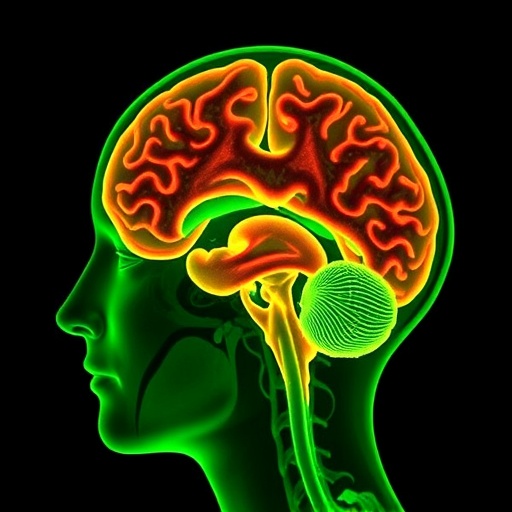In a groundbreaking study published in Translational Psychiatry, researchers have unveiled critical insights into the neurobiological underpinnings of posttraumatic stress disorder (PTSD) by examining the availability of cannabinoid 1 (CB1) receptors in the brain. Utilizing advanced positron emission tomography (PET) imaging technology, the investigation provides compelling evidence suggesting that CB1 receptor density plays a pivotal role in the pathophysiology of PTSD, potentially opening novel avenues for targeted therapeutic interventions.
PTSD, a debilitating psychiatric condition triggered by exposure to traumatic events, manifests through symptoms such as intrusive memories, hyperarousal, and emotional numbing. Despite its prevalence and the profound impact on quality of life, the neurochemical mechanisms governing PTSD remain only partially understood. The endocannabinoid system—particularly the CB1 receptor, which is predominantly expressed in the central nervous system—has emerged as a candidate for influencing stress-related disorders due to its regulatory role in emotional processing and memory.
The investigative team employed PET imaging, a sophisticated neuroimaging technique allowing visualization and quantification of specific receptor populations in vivo, to measure CB1 receptor availability directly within pertinent brain regions of individuals diagnosed with PTSD. This modality involves the administration of radioligands that selectively bind to CB1 receptors, producing signals detectable by the PET scanner. By precisely quantifying these signals, researchers can infer receptor density and distribution patterns correlated with PTSD symptomatology.
Their analyses revealed a marked reduction in CB1 receptor availability across several limbic and cortical areas implicated in emotion regulation and fear extinction, including the amygdala, hippocampus, and prefrontal cortex. These findings suggest that alterations in endocannabinoid neurotransmission may contribute to the disturbed stress responses and maladaptive memory processing characteristic of PTSD. Notably, diminished CB1 receptor density correlates with severity of core PTSD symptoms, highlighting potential biomarkers for disease progression.
Moreover, the study elucidated that the decreased receptor availability is unlikely to be a mere epiphenomenon but rather reflects underlying neuropathological changes, possibly involving receptor internalization or downregulation secondary to chronic stress exposure. This distinction carries substantial weight for therapeutic strategies aimed at modulating the endocannabinoid system, emphasizing the need for interventions capable of restoring receptor function or expression.
Beyond its scientific contributions, the research holds significant translational promise. The current pharmacological treatments for PTSD, including selective serotonin reuptake inhibitors (SSRIs), display limited efficacy and often come with considerable side effects. Targeting CB1 receptors directly or indirectly could present a novel class of therapeutics with potentially greater specificity and improved tolerability. Preclinical models have demonstrated that enhancing endocannabinoid signaling can ameliorate anxiety and facilitate fear extinction, reinforcing the clinical relevance of these PET imaging findings.
The study also addresses the complexities inherent in measuring receptor availability, acknowledging potential confounding factors such as receptor affinity changes and ligand competition. By employing rigorous methodological controls and advanced radioligands with high specificity and affinity for CB1, the researchers minimized these limitations, thus conferring robustness to their conclusions. Additionally, longitudinal assessments could further delineate whether CB1 alterations precede PTSD manifestation or represent consequences of chronic illness.
Importantly, this research invites a reevaluation of the paradigm by which PTSD is conceptualized neurobiologically. The involvement of the endocannabinoid system situates the disorder within a broader context of neuroplasticity and homeostatic regulation, challenging prevailing monoaminergic-centric models. This integrative approach acknowledges the multifaceted neurochemical disturbances accompanying PTSD and underscores the value of multimodal imaging combined with molecular neuroscience.
Furthermore, the implications extend into personalized medicine. Stratifying PTSD patients based on CB1 receptor availability patterns might inform individualized treatment plans, enhancing therapeutic response rates while minimizing adverse effects. Biomarker-driven approaches anchored by PET imaging data could optimize clinical outcomes and reduce the trial-and-error nature of current pharmacotherapies.
The study’s findings also fuel ongoing debates regarding cannabis use and PTSD. Although exogenous cannabinoids interact with CB1 receptors, their therapeutic role remains controversial due to the complex psychoactive effects and potential for dependency. By delineating the endogenous receptor alterations intrinsic to PTSD, the research clarifies the biological substrate underlying these concerns and may guide safer, more effective cannabinoid-based treatments.
Critically, future research is poised to explore the dynamic interplay between CB1 receptor availability and other neurotransmitter systems, such as glutamatergic and GABAergic pathways, which collectively orchestrate emotional regulation and stress resilience. Multimodal imaging studies combining PET with functional MRI could yield richer mechanistic insights, potentially identifying critical circuit-level dysfunctions amenable to intervention.
Moreover, the development of next-generation radioligands with enhanced resolution and sensitivity will refine our understanding of CB1 receptor physiology in both healthy and pathological states. These technological advances promise to transform neuropsychiatric research paradigms, advancing from static receptor mapping to real-time monitoring of receptor trafficking and signaling.
In conclusion, the demonstration of decreased CB1 receptor availability in PTSD patients via PET imaging represents a landmark discovery with profound implications. This research adds a vital piece to the puzzle of PTSD neurobiology, emphasizing the endocannabinoid system’s central role while charting a course for novel, receptor-targeted therapies. As neuroscience continues to unravel the mysteries of trauma-related disorders, such insights will be indispensable in fostering hope for millions affected worldwide.
Subject of Research: Cannabinoid 1 receptor availability in posttraumatic stress disorder
Article Title: Cannabinoid 1 receptor availability in posttraumatic stress disorder: A positron emission tomography study
Article References:
Korem, N., Bassir Nia, A., Hillmer, A.T. et al. Cannabinoid 1 receptor availability in posttraumatic stress disorder: A positron emission tomography study. Transl Psychiatry 15, 310 (2025). https://doi.org/10.1038/s41398-025-03519-9
Image Credits: AI Generated




